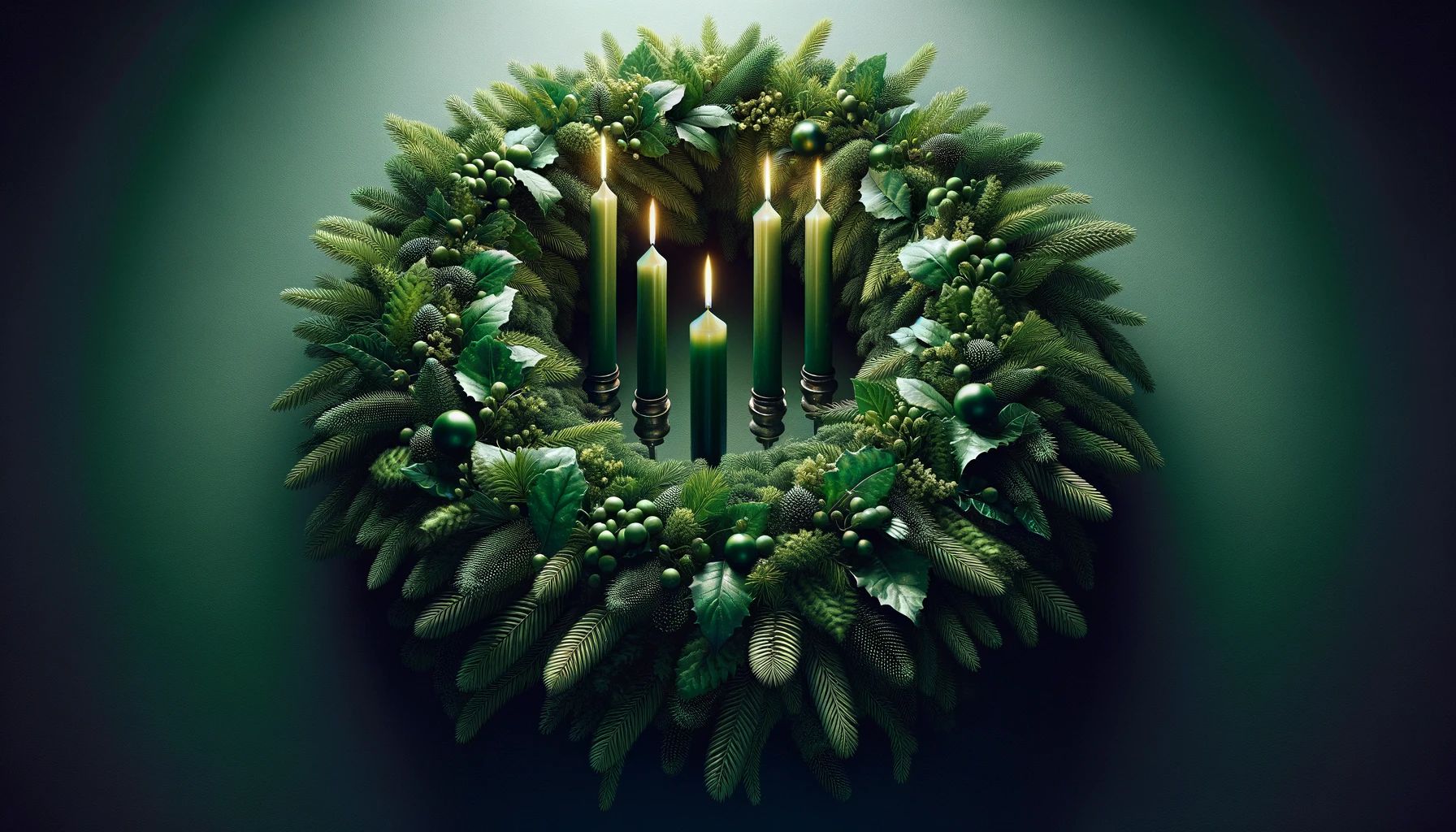Home>Special Themes>What Is The Purpose Of An Advent Wreath


Special Themes
What Is The Purpose Of An Advent Wreath
Published: February 12, 2024
Peter Smith, Editorial Director at Christian.net, combines deep insights into faith, politics, and culture to lead content creation that resonates widely. Awarded for his contributions to religious discourse, he previously headed a major organization for religious communicators, enhancing dialogue on faith's societal impacts.
Discover the significance and traditions of the Advent wreath, a cherished symbol of hope and anticipation during the holiday season. Learn about its special themes and the purpose it serves in Christian faith.
(Many of the links in this article redirect to a specific reviewed product. Your purchase of these products through affiliate links helps to generate commission for Christian.net, at no extra cost. Learn more)
Table of Contents
Introduction
The Advent wreath is a cherished symbol of the Advent season, a time of anticipation and preparation for the celebration of the birth of Jesus Christ. This timeless tradition has been observed by Christian communities around the world for centuries, serving as a poignant reminder of the spiritual significance of the holiday season.
The Advent wreath, typically adorned with evergreen foliage and four candles, holds a special place in the hearts of believers, as it symbolizes the hope, love, joy, and peace associated with the coming of Christ. As the Advent season unfolds, the lighting of the candles on the wreath marks the progression of time and the growing anticipation of the joyous occasion of Christmas.
This article delves into the rich history and symbolism of the Advent wreath, shedding light on its profound significance in Christian tradition. By exploring the origins, meaning, and customs associated with the Advent wreath, we can gain a deeper understanding of its role in fostering spiritual reflection and reverence during the Advent season.
Read more: What Does The Advent Wreath Symbolizes
History of the Advent Wreath
The history of the Advent wreath can be traced back to pre-Christian Germanic people, who utilized wreaths with lit candles during the cold and dark December days as a symbol of hope and light. However, the modern Advent wreath, as it is known today, originated in 19th-century Germany. Johann Hinrich Wichern, a Protestant pastor, is credited with creating the first Advent wreath in 1839.
Wichern worked with children at a mission school in Hamburg, where he sought a way to help them count down the days until Christmas. He constructed a large wooden ring with 20 small red and 4 large white candles. The small candles were lit on weekdays, while the larger candles were lit on Sundays. This innovative design provided a visual and interactive way for the children to mark the passage of time leading up to Christmas.
The concept of the Advent wreath gained popularity and spread to other parts of Germany and eventually to other Christian denominations across Europe. The symbolism of the wreath, with its evergreen foliage representing eternal life and the candles signifying the light of Christ, resonated deeply with believers. Over time, the Advent wreath became a cherished tradition in homes and churches, serving as a focal point for Advent devotions and prayers.
In the early 20th century, the Advent wreath tradition crossed the Atlantic and found its way into North American churches and households. Today, the Advent wreath is an integral part of the Advent season in many Christian traditions, symbolizing the spiritual preparation and anticipation of the birth of Jesus Christ.
The evolution of the Advent wreath from its humble beginnings to its widespread adoption reflects its enduring significance in Christian observance. This rich history underscores the enduring appeal and relevance of the Advent wreath as a powerful symbol of faith, hope, and the anticipation of the coming of Christ.
Symbolism of the Advent Wreath
The Advent wreath is steeped in profound symbolism, with each element holding deep spiritual significance. At its core, the circular shape of the wreath represents eternity and the unending love of God. This unbroken circle serves as a powerful reminder of the everlasting nature of God's love and the hope that Christ's coming brings to the world.
The evergreen foliage adorning the Advent wreath symbolizes enduring life and renewal. In the midst of winter, when nature appears dormant, the evergreen leaves serve as a poignant reminder of the eternal life found in Christ. The vibrant greenery represents the promise of new life and the unchanging faithfulness of God, even in the midst of challenging seasons.
Central to the Advent wreath are the candles, each carrying its own symbolic meaning. The four candles, typically three purple and one pink, represent the four weeks of Advent. The first purple candle symbolizes hope, reminding believers of the anticipation and expectation of the Messiah's arrival. The second purple candle signifies love, reflecting the boundless love of God manifested through the gift of His Son. The pink candle, lit on the third Sunday of Advent, represents joy, signifying the rejoicing that accompanies the imminent arrival of Christ. The final purple candle symbolizes peace, serving as a beacon of tranquility and harmony in the midst of a world yearning for divine peace.
The lighting of the candles on the Advent wreath also holds profound symbolism. As each candle is lit in succession, the increasing light serves as a metaphor for the growing anticipation and illumination brought by the coming of Christ. The progression from darkness to light mirrors the spiritual journey of believers as they prepare their hearts to welcome the birth of Jesus.
In essence, the Advent wreath encapsulates the core themes of the Advent season: hope, love, joy, and peace. It serves as a visual and symbolic focal point for believers to reflect on the profound meaning of Christ's birth and to cultivate a spirit of anticipation and reverence during this sacred time.
The rich symbolism embodied in the Advent wreath underscores its significance as a cherished tradition that continues to inspire and uplift individuals and communities as they prepare to celebrate the birth of Jesus Christ.
How the Advent Wreath is Used
The Advent wreath serves as a focal point for spiritual reflection and observance during the Advent season. Its usage is deeply rooted in tradition and is accompanied by meaningful rituals that guide believers through the weeks leading up to Christmas.
The lighting of the Advent candles is a central practice associated with the Advent wreath. Typically, the first candle, symbolizing hope, is lit on the first Sunday of Advent. Each subsequent Sunday sees the lighting of an additional candle, with the pink candle representing joy lit on the third Sunday. Finally, the fourth candle, signifying peace, is lit on the fourth Sunday of Advent. This gradual illumination of the candles mirrors the progressive anticipation of the birth of Christ and serves as a visual representation of the increasing spiritual light that emanates from the coming of the Savior.
Families and communities often gather around the Advent wreath for special devotional times. These gatherings provide an opportunity for shared prayer, scripture reading, and the singing of hymns that center on the themes of hope, love, joy, and peace. The Advent wreath becomes a focal point for these communal observances, fostering a sense of unity and spiritual connection as participants collectively prepare their hearts for the celebration of Christmas.
In addition to its significance in homes, the Advent wreath holds a prominent place in church services during the Advent season. Many congregations incorporate the lighting of the Advent candles into their worship services, with readings and reflections that correspond to each week's theme. This practice serves to guide worshippers through a period of introspection and spiritual preparation, aligning their hearts and minds with the profound significance of the Advent season.
The Advent wreath is a tangible and symbolic tool that aids believers in marking the passage of time and in cultivating a spirit of expectancy and reverence as Christmas approaches. Its usage extends beyond mere decoration, serving as a powerful catalyst for meaningful rituals and communal observances that deepen the spiritual significance of the Advent season.
The enduring tradition of the Advent wreath's usage underscores its role as a cherished and integral component of the Advent season, providing a framework for spiritual engagement and reflection as believers journey towards the celebration of the birth of Jesus Christ.
Importance of the Advent Wreath in Christian Tradition
The Advent wreath holds profound importance in Christian tradition, serving as a poignant symbol of spiritual preparation, anticipation, and the enduring hope found in the birth of Jesus Christ. Its significance extends beyond mere ornamentation, as it plays a pivotal role in guiding believers through a period of introspection and reverence during the Advent season.
At the heart of its importance is the Advent wreath's ability to encapsulate the core themes of the Advent season: hope, love, joy, and peace. As believers engage with the lighting of the candles and the accompanying rituals, they are drawn into a deeper contemplation of these fundamental aspects of faith. The progression from the first candle of hope to the final candle of peace mirrors the spiritual journey of believers as they prepare their hearts to welcome the birth of Jesus. This intentional focus on the foundational elements of Christian faith fosters a sense of spiritual renewal and anticipation, enriching the Advent experience for individuals and communities.
Furthermore, the Advent wreath serves as a unifying symbol within Christian households and congregations. Families gather around the wreath for shared devotional times, fostering a sense of togetherness and spiritual connection as they collectively prepare for the celebration of Christmas. Similarly, in church settings, the lighting of the Advent candles and the corresponding readings and reflections provide a framework for communal worship and spiritual engagement. The Advent wreath becomes a focal point for these collective observances, reinforcing a sense of unity and shared purpose as believers journey through the Advent season.
The enduring tradition of the Advent wreath in Christian communities underscores its role as a cherished and integral component of the Advent season. Its ability to evoke a spirit of anticipation, reflection, and unity aligns with the foundational principles of Christian faith, making it a timeless and meaningful tradition for believers around the world.
In essence, the Advent wreath holds a place of profound importance in Christian tradition, serving as a tangible and symbolic expression of the spiritual journey towards the celebration of the birth of Jesus Christ. Its enduring relevance and impact on the faith experience of believers underscore its significance as a cherished and integral tradition within the Christian community.
Read more: What Are The Symbols Of Advent Wreath
Conclusion
In conclusion, the Advent wreath stands as a timeless and cherished symbol of the Advent season, embodying the profound themes of hope, love, joy, and peace that characterize the anticipation of the birth of Jesus Christ. Its rich history, rooted in both pre-Christian traditions and 19th-century innovations, reflects its enduring appeal and significance in Christian observance.
The symbolism embodied in the circular shape, evergreen foliage, and candles of the Advent wreath serves as a poignant reminder of the eternal love and unchanging faithfulness of God. The gradual illumination of the candles throughout the Advent season mirrors the progressive anticipation and spiritual enlightenment brought by the coming of Christ, fostering a sense of reverence and expectancy among believers.
Furthermore, the Advent wreath's usage in homes and churches provides a framework for meaningful rituals and communal observances, guiding individuals and communities through a period of introspection and spiritual preparation. Its ability to foster unity, togetherness, and shared devotion underscores its role as a unifying symbol within Christian households and congregations.
The enduring importance of the Advent wreath in Christian tradition is evident in its ability to evoke a spirit of anticipation, reflection, and unity, aligning with the foundational principles of Christian faith. As believers engage with the Advent wreath, they are drawn into a deeper contemplation of the core themes of the Advent season, enriching their spiritual journey towards the celebration of the birth of Jesus Christ.
In essence, the Advent wreath holds a place of profound significance in Christian observance, serving as a tangible and symbolic expression of the spiritual preparation and anticipation of the coming of Christ. Its enduring relevance and impact on the faith experience of believers underscore its role as a cherished and integral tradition within the Christian community, continuing to inspire and uplift individuals and communities as they prepare to celebrate the birth of Jesus Christ.














